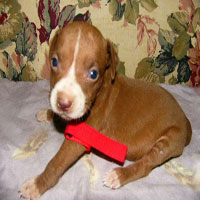 |
Puppies:
The most troublesome and boring aspect of owning a pet pitbull according to most owners is training. Though boring, early obedience training for pitbulls is very essential, otherwise they may become disobedient and even aggressive. A poorly bred pitbull is often a danger to the people around it. Also, it is necessary to teach housebreaking to a pitbull when it is still a puppy.
The first thing that a pitbull needs to be trained in is housebreaking. Pit bull puppies have weak bladders, which they may need to eliminate almost every hour. Have specific meal times for the puppy and then take it out. Over time, puppies will begin to recognize this place by its smell. It's no fun to be woken in the middle of a night by a puppy whining to go potty, but it takes endurance in the first few months. As pitbulls grow older, their bladder control improves, but it will be a while before they can hold their bladders overnight. Another method is paper training, where newspaper can be spread at spots within the house. However, paper training is not good as it gives the pitbull the idea that it is okay to poop inside the house. |
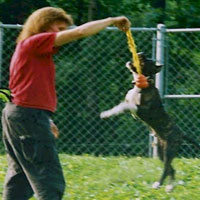 |
Training:
Pitbulls are athletic dogs and so they need stamina and strength training. The most common way to teach almost all dogs is by drive and tracking. A ball and string can be used for this. Show the ball to the pitbull until its curiosity is aroused and then roll the ball on the floor, away from the pit bull. The pitbull will begin chasing after it. Using this tactic, several tricks can be taught to the pitbull.
Pitbulls are intelligent dogs. They respond to commands. Pit bulls can be trained to understand commands such as 'go', 'fetch', 'heel' and they also recall to their names. Repeating the commands over and over helps the dog to learn faster. Such obedience training must not be taken lightly as it may sometimes be a lifesaver to the dog.
Training a dog requires patience and affection on the part of the trainer. Pitbulls are sensitive and they should never be hit or yelled at when training. This may have an adverse effect and they may not respond to training at all. They may also fight back and nip or bite people. A slight reprimand, with a strong 'No' is enough to make a pitbull stop any undesirable activity. It is important to be consistent in pit bull training. If you train a pitbull for a couple of days and then decide to take a break, then the whole thing is going to be a worthless affair.
However, there are many ways in which pit bull training can be made exciting to both dog and owner. The training also provides some exercise to the owner and goes a long way in making the dog a trustworthy and able companion. |
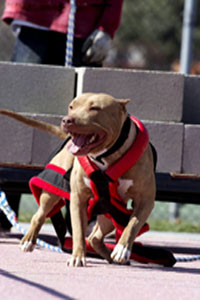 |
Medical:
Built for performance, the pit bull is a medium sized, very muscular, short coated breed. The head is bricklike, the jaws strong and wide, the ears may be cropped or not. The body is typically very strong, with a deep chest, powerful and proportionate hind end and solid legs. The overall impression should be of power and athleticism. This is not a dog for couch potatoes, as it requires A LOT of training and exercise. With this breed it is important to remember to exercise both the dog's body and mind. Remember, a tired pit bull is a happy pitbull and a bored pit bull is NOT a good thing! They will find some very inventive ways to entertain themselves that the owner may not like (often involving the garbage can, kitchen counter and cabinets, feather pillows, dirty laundry and various items of furniture). Remember also, that this is a VERY enthusiastic breed that may very well overwhelm young children or older people with it's affection. This breed needs to be taught to sit and greet people calmly as it's natural inclination will probably be to climb into their lap, put a paw on each of their shoulders, and attempt to wipe their face off with it's tongue. Attempts to convince a full grown pit bull that it is too big to be a "lap dog" will, more often than not, fall on deaf ears if it was not taught "manners" as a puppy. Do not allow your puppy to do anything you don't want your adult dog to do (eg climb on the couch, sleep in the bed, invade your lap, etc.).
|
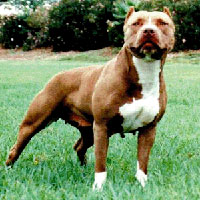 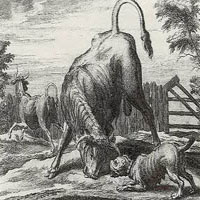 |
Working and Exercising:
The original pitbull is never been big and sluggish. His ability to fight also is beyond any doubt, because as in ancient times, as in today he is showing it in its duels. His legendary abilities are real and every one, who’s doubt in them, can see them in action. It is not logical the ancient Babylons and romans fill with admiration of the dog’s strength, but the minors from Stafordshir and the producers of lace from Birmingam uneducated to dispute it. Leaded out from the lord’s homes and well-to-do middle class, the pitbull fall in to the hands of uneducated, simple people, who must save its abilities, and let’s not talk about the money and the opportunities they have. The lower class of the English society, is the one who find pitbull’s bearings to dogs and rats fight. They cross-breeding him and “made improvements”, at least they thing so.
Much of a dog's temperament relates to its breed history and genetic inheritance. I won't go too deep into the history of the PitBull as there are many good books and websites that cover the origin and history of the breed. It is common knowledge however, that the PitBull breed was developed for blood sports: Bull baiting, bear baiting, and later, dogfighting. What is not common knowledge is that in the days of organized dogfighting, the handlers of the combatants were habitually IN THE PITBULL with the dogs for the duration of the fight. They were required to pick up and separate the dogs several times while the dogs were in full fight frenzy. Before the fight, the handlers were required to wash each other's dogs, and after the fight, the badly injured dogs were often treated at ringside by strangers. Any dog that attacked or bit a handler (even if it was the other dog's handler) or anyone else at any time was culled, often on the spot, and would never have been bred.
|